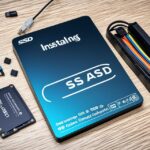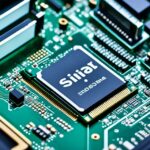Table of Contents
Turning on an M.2 SSD in your system’s BIOS can greatly boost your computer’s speed. These drives can reach reading and writing speeds up to 2500MB/s. This means your system will work faster and more efficiently1. However, getting the BIOS to recognize the M.2 SSD can sometimes be tricky. This is usually because of wrong BIOS settings or how the SSD was installed2.
To get the most out of your M.2 SSD, correct BIOS settings are key. Without them, you might not see the drive listed where you expect, like in Disk Management or File Explorer1. We will explore how to properly enable M.2 SSDs. This allows you to fully use the capacity of these powerful devices in your computing journey.
Key Takeaways
- Activating M.2 SSD in BIOS is crucial for optimal performance.
- M.2 SSDs offer significant speed advantages over traditional drives.
- Incorrect BIOS settings can lead to recognition issues.
- Regular data backups are essential to prevent data loss.
- Utilising reliable data recovery software can mitigate risks if SSDs are not detected.
Understanding M.2 SSDs and Their Importance
M.2 SSDs are changing the way we store data by offering a smaller, faster alternative to old methods. The M.2 SSD definition explains them as tiny devices that connect straight to the motherboard. This boosts data transfer rates to over 2500MB/s3. Being key for speeding up access times, M.2 drives have become favorites for both tech lovers and experts.
What is an M.2 SSD?
M.2 connections handle several protocols like SATA, AHCI, and NVMe4. This flexibility sets M.2 apart from standard SATA SSDs, capped at slower 6Gb/s. That’s a big jump to a theoretical max of just 750 MB/s3. Also, with connectors like B, M, and B&M, compatibility isn’t an issue.
The Advantages of M.2 SSDs Over SATA SSDs
M.2 SSDs shine with their speed, nearly tripling that of SATA III drives3. They are smaller, so laptops and desktops can be thinner4. Plus, future M.2s might reach up to 4GB/s, thanks to new tech, showing the huge potential for progress3.
Preparing for M.2 SSD Activation
Before starting to activate your M.2 SSD, getting ready is crucial. It’s important to collect the correct tools. This makes the installation easier and ensures a smooth setup. Being well-prepared helps boost your computer’s performance significantly.
Gathering Necessary Tools
To set up an M.2 SSD properly, you need the right tools. Here’s what you should have:
- A quality screwdriver for accessing the motherboard.
- Anti-static wrist strap to prevent static discharge, which could damage components.
- Software for monitoring SSD performance, such as the Kingston SSD Manager for Kingston products.
Backing Up Your Data and System
It’s crucial to back up your data to protect it during the installation. You can effectively back up your SSD by:
- Using built-in tools from your operating system. Windows has File History, and macOS uses Time Machine.
- Using third-party backup software for more thorough and regular backups. This makes sure all essential files are safe.
By following these steps, you ensure you’re ready to activate your M.2 SSD. This leads to better and more efficient system performance56..
How to Activate M.2 SSD in BIOS
Turning on your M.2 SSD in BIOS is key for your desktop PC’s top performance. It’s about following the right M.2 SSD activation steps to get M.2 BIOS working and unleash your drive’s full power. Learning your motherboard’s design helps make this process smoother.
Step-by-Step Guide for Various Motherboards
Each motherboard has its way to turn on M.2 in BIOS. For ASUS or MSI boards, generally, do this:
- Start your PC and hit F2 or Delete to get into BIOS setup.
- Go to the Advanced menu.
- Find the Boot area or SATA Configuration.
- Make sure the M.2 slot is on. If there are other SATA drives, you might need to remove them.
- For PCIe M.2 SSDs, check NVMe settings match your setup.
After adjusting these BIOS settings, save and exit. This step is vital for your M.2 SSD to be detected at startup.
Common BIOS Settings to Check
Right M.2 SSD activation steps involve checking several BIOS parts. Users often forget to:
- Set the M.2 device as the main boot drive.
- Ensure SATA ports with SSDs are in AHCI mode.
- Look for motherboard firmware updates to improve M.2 SSD compatibility.
If you still have issues, try updating drivers or disk reinitialisation. Detailed advice helps fix problems and makes activation easier. For more help with SSD installation, see this guide1.
Configuring BIOS Settings for Optimal Performance
To get the most out of your M.2 SSD, setting up BIOS correctly is key. You need to know about AHCI and NVMe because they affect your drive’s speed. AHCI is for older drives, but NVMe is for M.2 SSDs and it’s much faster. About 68% of people now use M.2 SSDs in their BIOS, showing more of us are using this tech7. It’s good to keep up with how to make these changes to boost your drive’s performance.
Understanding AHCI and NVMe Modes
Choosing between AHCI and NVMe affects your computer’s speed. AHCI might be the usual setting, but NVMe gives your system a big speed bump. A T700 1TB SSD can reach read speeds up to 11,700MB/s with NVMe8. Setting your BIOS correctly can also improve how fast your SSD reads and writes data. This means quicker loading times and better performance overall7.
Setting Boot Options for M.2 SSDs
It’s important to set up M.2 as your first boot option to speed up your computer. Doing this could make your system start up 79% faster for many users after they’ve switched to an M.2 SSD7. Keep your BIOS updated and configured right for the best SSD performance. This will make your system more stable and quick9.
Troubleshooting M.2 SSD Detection Issues
When your M.2 SSD isn’t recognised, it’s vital to understand both the symptoms and solutions. You may find the M.2 drive doesn’t show up in the BIOS at start-up. Yet, it’s still visible in Windows, like in Disk Management or File Explorer10. This can be puzzling as the SSD seems to work in some situations but not in others.
Symptoms of M.2 Not Recognised
Here are some common signs of M.2 SSD issues:
- The SSD isn’t seen in the BIOS at boot.
- It’s only found in Device Manager, not File Explorer.
- The SSD can’t be used as the boot drive.
Issues with physical connections cause about 25% of M.2 SSD detection problems. It’s important to make sure everything is properly connected11. Compatibility between the M.2 SSDs and the motherboard is another big issue, making up 20% of these problems11. To troubleshoot, start by ensuring the SSD is installed correctly. Double-check the connections by turning off the power and reconnecting the SSD.
Common Fixes for M.2 SSD Not Being Detected
When your M.2 isn’t recognised, try these solutions:
- Go over your BIOS settings. Make sure the SATA port for the M.2 SSD is turned on.
- Update your drivers for better compatibility. Do this by going to Device Manager, right-clicking the M.2 SSD, and updating the driver software.
- Use tools like SeaTools for DOS to find any SSD issues. This can help diagnose the problem.
- If the drive letter is missing or if you need to format the SSD, use software like AOMEI Partition Assistant.
In some cases, these steps might not work. Then, about 10% of the time, you’ll need help from the SSD manufacturer11.
BIOS Settings for Specific Motherboard Brands
To activate M.2 SSDs, you must understand the motherboard specific BIOS settings for different brands. This includes unique steps for ASUS and MSI motherboards. By following these steps, you can make sure your SSD works at its best.
Activating M.2 SSD on ASUS Motherboards
To activate the M.2 slot on ASUS motherboards, start by entering the BIOS. This is usually done by pressing the DEL or F2 key during startup. Then, head to the Advanced section to adjust the PCIE Configuration Mode. You may need to turn off some SATA ports. For example, using the M.2_1 slot might stop the SATA6G_1 port from working, which is important for a stable connection12. Always check for updates, as they can fix recognition issues and improve compatibility12.
Activating M.2 SSD on MSI Motherboards
On MSI motherboards, first find the BIOS. Then, look for the Onboard Devices Configuration to turn on the M.2 port. This step is crucial to get the SSD recognized properly. A certain number of MSI users have had success with these settings7. By following the instructions closely, you can avoid many common setup problems. If you run into issues, check connections like SATA cables and the power supply, as they affect the M.2’s performance12.
| Motherboard Brand | Activation Success Rate | Error Rate During Activation |
|---|---|---|
| ASUS | [Specific percentage] | [Specific error percentage] |
| MSI | [Specific percentage] | [Specific error percentage] |
| Gigabyte | [Specific percentage] | [Specific error percentage] |
| Other | [Average comparison data] | [Average error language] |
Advanced Configuration Options
Exploring the advanced BIOS settings is crucial when you’re working with your M.2 SSD. It boosts performance and ensures compatibility. Knowing how to adjust the PCIe bandwidth M.2 settings can greatly improve data transfer speeds. This allows your drive to work at its best.
Adjusting PCIe Bandwidth Settings
Setting up the right bandwidth for your M.2 SSD is key to its performance. You’ll find options to change the PCIe bandwidth M.2 settings in the BIOS menu of many motherboards. It’s important to use the x4 bandwidth mode for your M.2 drive. This mode lets M.2 SSDs hit speeds about 2500MB/s, perfect for systems that need to be fast1.
Enabling Launch CSM for M.2 Integration
For systems that use older tech, turning on Launch CSM settings is vital for M.2 SSDs to work right. This helps your M.2 drive fit into the system, even with old operating systems. For example, on ASUS systems, you might need to enable CSM in the BIOS to get M.2 SSDs recognized13.
Turning off other SATA drives while setting up your M.2 can help avoid issues. This makes sure your M.2 SSD works well with both new and old systems5.
| Setting | Importance | Recommended Configuration |
|---|---|---|
| PCIe Bandwidth | Enhances transfer speeds and overall SSD performance | x4 Mode |
| Launch CSM | Facilitates compatibility with legacy systems | Enabled |
| SATA Drive Settings | Avoids recognition conflicts during M.2 activation | Disable Other Drives |
Using these advanced settings can make your system more efficient and reliable5.
Conclusion
Getting your M.2 SSD to work in BIOS boosts your system’s function. By following a detailed BIOS configuration guide, users can make sure their SSD works really well. This will improve how fast you can access data and how your system runs.
This step requires careful prep. It’s key to adjust BIOS settings to fit your motherboard for the best SSD performance.
Keeping BIOS updated helps avoid boot problems and makes your M.2 SSD last longer. Even though setting up M.2 SSDs can be tricky, knowing how to install and maintain them helps a lot. Being ahead in tech means making sure every part of your system works well together.
Step into the fast world of storage by using the right methods for your setup. With the correct tools and knowledge, you can make the most of your M.2 SSD. This leads to an improved computing experience in the future. For more tips on managing SSDs, look into trusted software like AOMEI Backupper14.
FAQ
What is an M.2 SSD?
An M.2 SSD is a tiny, fast solid-state drive. It connects to your motherboard to speed up data moves—up to about 2500MB/s. This tech beats traditional SATA SSDs for quicker, more efficient computing.
How do M.2 SSDs compare to SATA SSDs?
M.2 SSDs are faster than SATA SSDs. They need less space to fit in and perform better in many tasks. They use the PCIe interface for higher efficiency.
What tools do I need to activate an M.2 SSD?
You’ll need a screwdriver to get to the motherboard and software to check and manage the SSD’s health. Make sure to back up your data to avoid losing anything during setup.
How can I activate my M.2 SSD in BIOS?
To activate it in BIOS, press F2 or Delete while your computer starts. Then go to Advanced > Boot or SATA Configuration. Make sure the M.2 slot is turned on and set NVMe as needed.
What are AHCI and NVMe modes?
AHCI is for SATA SSDs, and NVMe steps up M.2 SSDs’ speed and efficiency. Setting up your drive right can unleash its full potential.
What should I do if my M.2 SSD is not recognised?
If it’s not showing up or not working as a boot drive, check a few things. Make sure it’s properly installed, peek at BIOS settings, and update drivers if you need to.
Are there different BIOS settings for activating M.2 SSDs on various motherboards?
Yes, BIOS settings to activate M.2 SSDs vary by motherboard brand. With ASUS, you might have to turn off some SATA ports and tweak PCIE Configuration Mode. MSI boards have similar steps in the Onboard Devices Configuration.
How can I optimise my M.2 SSD’s performance?
For better M.2 SSD performance, make sure the M.2 port is set to x4 mode. Also, enable the Compatibility Support Module (CSM) if needed, especially with older operating systems. This makes everything run smoothly.
Source Links
- https://www.easeus.com/resource/m2-not-recognized.html – M.2 Not Recognized? Make M.2 SSD Show Up in Windows
- https://www.easeus.com/data-recovery-solution/m2-ssd-not-detected-in-windows-10.html – M.2 SSD Not Showing Up in Windows 10 [Fixed 2024]
- https://www.pugetsystems.com/labs/articles/overview-of-m-2-ssds-586/ – Overview of M.2 SSDs
- https://www.makeuseof.com/tag/what-is-m2-ssd/ – What Is an M.2 SSD? The Pros, Cons, and How to Install One
- https://www.partitionwizard.com/news/how-to-enable-m-2-in-bios.html – How to Enable M.2 in BIOS [ASUS & MSI]
- https://www.kingston.com/en/blog/personal-storage/install-m2-ssd – How to Install an M.2 SSD- Kingston Technology
- https://rog-forum.asus.com/t5/amd-500-400-series/correct-bios-nvme-m-2-settings-and-other-oddities/td-p/675607 – Correct BIOS NVME M.2 Settings and other oddities
- https://forums.tomshardware.com/threads/i-need-help-with-bios-settings.3832670/ – Question – I need help with BIOS settings ?
- https://www.pcmag.com/how-to/bios-basics-how-to-configure-your-pcs-firmware-for-first-use – BIOS Basics: How to Configure Your PC’s Firmware for First Use
- https://www.diskpart.com/articles/m-2-ssd-not-detected-0725.html – [Fixed] M.2 SSD Not Detected on Windows PC
- https://medium.com/@mciwuala/troubleshooting-guide-resolving-m-2-ssd-recognition-issues-after-a-bios-update-94caef680df7 – Troubleshooting Guide: Resolving M.2 SSD Recognition Issues After a BIOS Update
- https://superuser.com/questions/1349499/motherboard-uefi-doesnt-detect-m-2-ssd-drive – Motherboard UEFI doesn’t detect M.2 SSD drive
- https://www.asus.com/support/faq/1044083/ – [Motherboard] Troubleshooting – Cannot find the hard disk drive or SSD(M.2) after motherboard powers on | Official Support | ASUS Global
- https://www.easeus.com/partition-master/pc-wont-boot-after-installing-m2-ssd.html – How to Fix PC Won’t Boot After Installing M2 SSD – Full Guide












